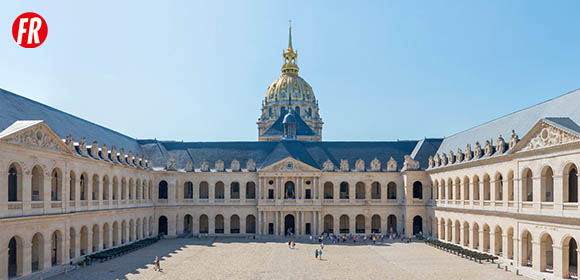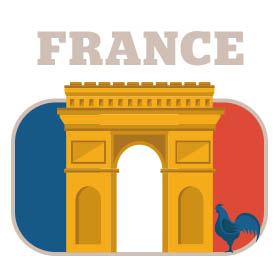
Paris, the city of romance and art, is home to world-famous landmarks such as the Eiffel Tower and the Arc de Triomphe. The Louvre with its rich collections, the Palace of Versailles with its sumptuous splendor, the Champs Elysees with its luxurious elegance… They all make Paris the most attractive city to visit in the world.
Historical Axis
On the north bank of the Seine River in Paris, there is a 10-kilometer-long urban axis. From the Arc de Triomphe, it passes through the Champs Elysees, the Tuileries Garden and ends at the Louvre. This scenic area of parks and green spaces is a place of relaxation for local people, and is lined with the Grand Palais, the Petit Palais, and the Musee de l’Orangerie, among many other attractions.

Louvre Museum
9,000 Years of Human History
The Louvre Museum is the most visited museum in the world, with its famous glass pyramid in the center of the square. The Louvre's three wings, Richelieu, Denon and Sully, contain artifacts from Egypt, Greece, Rome and Near East, as well as paintings and decorative arts.

Avenue des Champs-Elysees
A World Famous Commercial Avenue
The Champs-Elysees, the world's most famous commercial street, stretches approximately 2 km from the Arc de Triomphe in the west to Place de la Concorde in the east. Lined with landmarks, luxury stores, green parks and street art, the Champs-Elysees is an unforgettable boulevard.

Arc de Triomphe
Emblem of Paris City
The Arc de Triomphe is located in the center of the Place Charles de Gaulle, the starting point of the western end of the Champs-Elysees, and was built in 1806 by order of Napoleon I. The Arc de Triomphe is the most important building in Paris. The facade has four sculpted groups and the interior has exhibition areas. The viewing platform at the top of the gate provides a panoramic view of Paris city.

Tuileries Garden
The First Royal Garden Opened in Paris
The Tuileries Garden originated in 1564 as a garden attached to the Tuileries Palace in Paris. It is located on the eastern extension of the Champs-Elysées, connecting Place de la Concorde to the Louvre. The garden is a comfortable and pleasant environment with fountains, sculptures, and boulevards inside.

Musee de l'Orangerie
Water Lilies by Impressionist Monet
Located in the Jardin des Tuileries in Paris, the Musée de l'Orangerie is considered the sanctuary of French Impressionism. The eight pieces of the Water Lilies series by Monet are displayed in two oval galleries on the first floor, and the museum also has paintings by Cézanne, Renoir, Picasso, and others in its collection.
The Seine in Paris
Flowing over northern France, the Seine River runs through the city of Paris and is known as the river of life in Paris. Locals often say that you don’t really know Paris until you walk along the banks of the Seine. The artistic atmosphere that pervades the banks of the Seine, the bridges, the vintage bookstalls, not to mention the Eiffel Tower, which stands on the south side of the river, will all enchant you.

The Seine In Paris
River of History and Inspirations
The Seine River flows through northern France and passes through the heart of Paris, linking historic landmarks such as the Île de la Cité, Notre Dame, the Louvre and the Eiffel Tower. The banks of the Seine in Paris became a World Heritage Site in 1991.

Eiffel Tower
Centennial of the French Revolution
The Eiffel Tower in Paris was built in 1889, and at 324 meters high, it held the record for the world's tallest building for more than 40 years. The Eiffel Tower is the symbol of Paris and can be admired from different angles from the Champ de Mars, the Jardins du Trocadéro and the Palais de Chaillot.

Pont Alexandre III
Beaux-Arts Style Arc on the Seine
The Alexander III Bridge connects the Les Invalides and the Grand Palais across the Seine. The bridge is named after Tsar Alexander III of Russia and commemorates the Franco-Russian alliance. It is considered the most beautiful bridge in Paris because of its rich gilding and sculpted figures.
Museums in Paris
Paris is the city with the highest quality of museums in the world. The Louvre, the Musee d’Orsay and the Centre Pompidou are the top three, which hold sculptures, paintings and other treasures from Mesopotamia, Ancient Egypt, Greece, Rome and all over Europe, spanning nearly 10,000 years.

Louvre Museum
9,000 Years of Human History
The Louvre Museum is the most visited museum in the world, with its famous glass pyramid in the center of the square. The Louvre's three wings, Richelieu, Denon and Sully, contain artifacts from Egypt, Greece, Rome and Near East, as well as paintings and decorative arts.

Orsay Museum
Modern Western Art Masters
The Musée d'Orsay is located on the south bank of the Seine in Paris, across the river from the Louvre. The collection of the Musée d'Orsay, created between 1848 and 1914, includes masterpieces by Impressionists such as Manet, Monet and Renoir, and sculptors such as Rodin and Rude.

Centre Pompidou
Treasures of Modern Art
Centre Pompidou, known as the Centre national d'art et de culture Georges-Pompidou, houses works by masters such as Picasso, Matisse and Chagall, and is one of the top museums of modern art in the world. The architecture of the Centre Pompidou itself is also a rare artistic masterpiece.
In addition to these comprehensive museums, Paris has many more distinctive museums: the Musée national des Arts asiatiques-Guimet is famous for its Asian art, the Musee des Arts Decoratifs in Paris focuses on furniture and interior design, the Musée Rodin and the Musée National Picasso in Paris are dedicated to artworks of a particular master.

Guimet Museum
Oriental Treasures in Paris
Guimet Museum in Paris has a collection of Asian artworks from China, India, Japan, Southeast Asia, and other regions. Its collection covers different categories such as bronzes, ceramics, stone carvings, paintings and calligraphy, etc.

Rodin Museum
The Father of Modern Sculpture
The Rodin Museum in Paris was converted from Rodin's former residence, the Hotel Biron. In this grand mansion and gardens, Rodin's sculptural masterpieces such as The Thinker, The Age of Bronze, The Kiss, and The Gates of Hell are on display, along with Rodin's collection of Monet and Van Gogh paintings.
Palace of Versailles
Located in the western suburbs of Paris, the Palace of Versailles (Château de Versailles) is a French palace built in the 17th century and a symbol of European palace architecture. The Hall of Mirrors with its 357 mirrors, the War Salon with dozens of large paintings, the Salon of Hercules with the astonishing ceiling fresco, Private apartments of the King and Queen, and the extensive gardens are just some of the reasons why you must visit Versailles.

Palace Of Versailles
Pinnacle of Palace Architectures
Built in the 17th century, Palace of Versailles is an icon of European palace architecture, with Baroque-style decorations and exquisite frescoes. Versailles houses countless halls, suites, salons, and gardens filled with fountains and statues.
The Glory of France
The French Revolution put Napoleon I on the wheels of history, and he drove the Gallic chariot across the battlefields of Europe. Les Invalides in Paris, located on the left bank of the Seine, records every detail of the military history of France. The coffin of Napoleon I is housed here in a golden dome 107 meters high.

Les Invalides
Monument of Military History of France
Located on the left bank of the Seine, Les Invalides de Paris was built by Louis XIV as a sanatorium for disabled French veterans, and in the 19th century the dome of Les Invalides was converted into the Tome of Napoleon I. At present, the Army Museum of France is also located here, with a collection of 500,000 artifacts.

Tomb Of Napoleon / Dome des Invalides
Founder of An Empire
The Dome des Invalides, with its 107-meter-high golden dome, was converted into a mausoleum for Napoleon I in the 19th century, and several members of the Bonaparte family and French marshals such as Foch, Vauban, and Turenne are buried there.

Army Museum
Art of War and Art about War
The Musée de l'Armée is located at Les Invalides and is one of the most important military museums in the world. The museum is divided into separate galleries for ancient, modern, and contemporary military exhibitions, etc. The collections here include weapons, armor, uniforms, paintings, and modern weapons.
The Pantheon in Paris is also located on the Left Bank, it is the burial place of many national heroes and great men of France. Voltaire, Rousseau, Victor Hugo and Madame Curie, who dedicated their lives to the glory of France, are buried in the crypt of Pantheon and are honored by their descendants.

Pantheon In Paris
Resting Place for Great People of France
Built in the 18th century, the Panthéon in Paris has an 83-meter-high dome and a facade modeled after the Pantheon in Rome. The Panthéon is the burial place of the great men of France, such as Voltaire, Rousseau, Victor Hugo, and the Curies, who are buried in the underground chambers of the Panthéon.
Attractions in Paris
- Eiffel Tower
- Arc de Triomphe
- Louvre Museum
- Palace Of Versailles
- Avenue des Champs-Elysees
- Orsay Museum
- The Seine In Paris
- Les Invalides
- Tomb Of Napoleon / Dome des Invalides
- Army Museum
- Pantheon In Paris
- Musee de l'Orangerie
- Tuileries Garden
- Rodin Museum
- Pont Alexandre III
- Centre Pompidou
- Guimet Museum






























